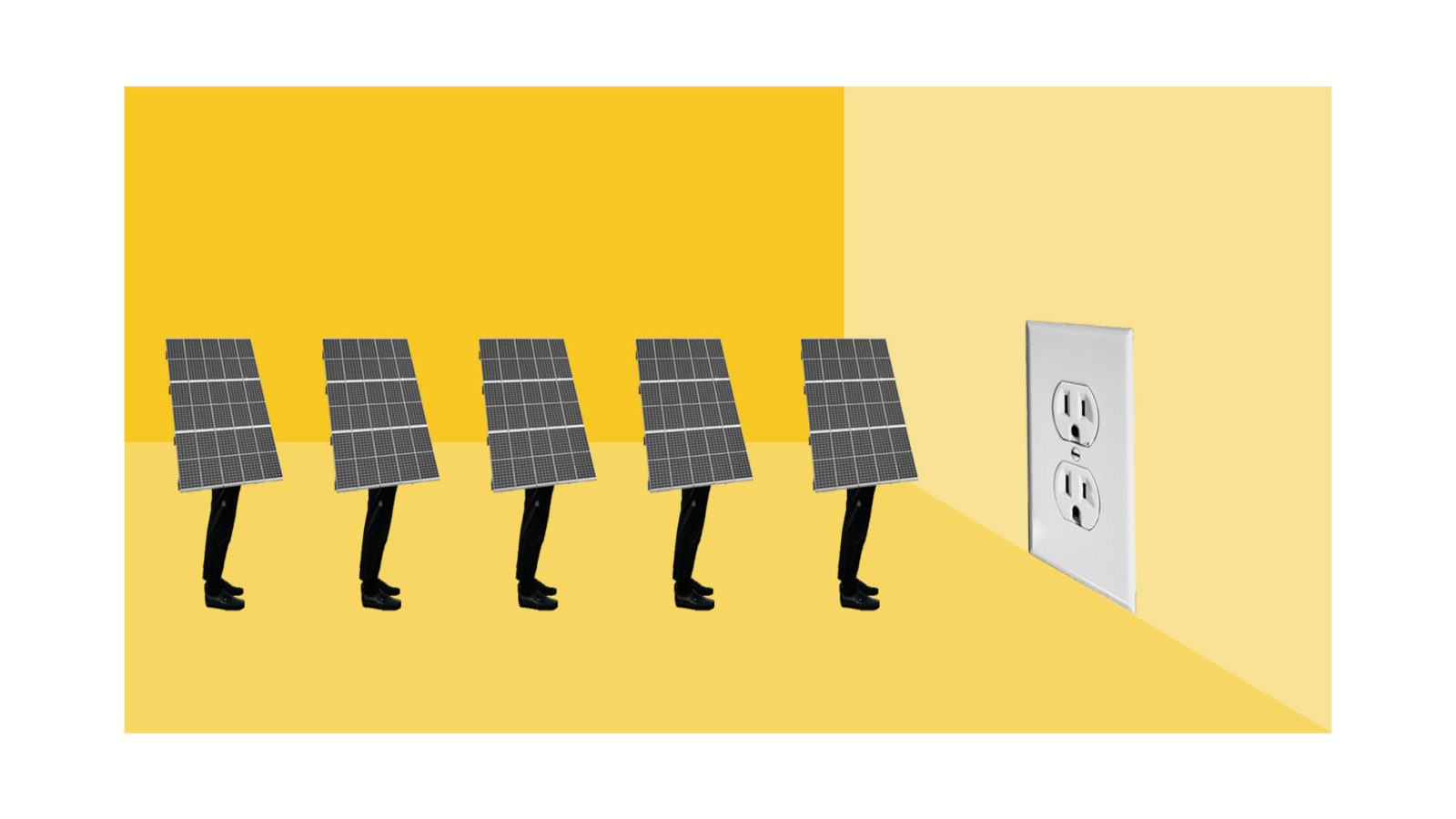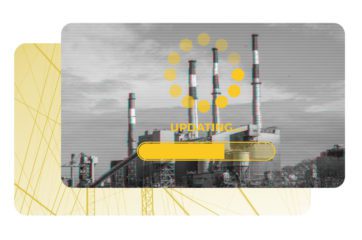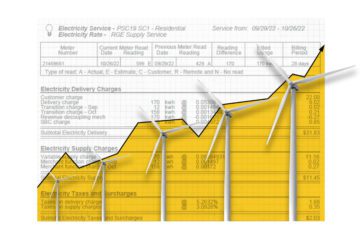Climate XChange’s Dashboard Digest is a deep dive on each of the policies that we track in the State Climate Policy Dashboard and an exploration of how these policies can interact with one another to form a robust policy landscape. The series is intended to serve as a resource to state policy actors who are seeking to increase their understanding of climate policies, learn from experts in each policy area, and view examples of states that have passed model policies. We’re beginning our series by exploring renewable energy and energy storage policies.
Anyone who’s ever been to the DMV knows the importance of smooth administrative procedures. You may have chosen the quick-moving line, brought the proper paperwork, and left feeling satisfied with your driver’s license in hand. Or, like many other people, you were confused by complicated document lists, had to pay unexpected fees, and waited hours before your line moved an inch.
It’s clear that administrative processes can play a large role in the efficiency of government systems, but when it comes to connecting renewable energy to the grid, the stakes are a lot higher than spending your afternoon at the DMV. Renewable energy has a “DMV” of its own to deal with — a complicated puzzle of federal, state, and local regulations that can slow the process of connecting new projects to the grid to a standstill. Ideally, this process should be as simple and streamlined as possible so that we don’t have renewables “waiting in line.” State policy can indeed make this easier for everyone through a foundational policy called Interconnection Standards.
Interconnection Standards are the rules and procedures that must be followed to connect a new renewable energy project to the grid. This can be for customer-sited projects like residential solar panels or utility-scale projects, but most often has to do with the former. It’s extremely important that states have standardized interconnection procedures to ensure that connecting to the grid is simple, streamlined, and affordable for utilities, renewable developers, and ratepayers. In this article for our Dashboard Digest series, we’re taking a look at the administrative and technical side of renewable development and why this policy is fundamental for states to overcome barriers to renewable energy.
Overall State Policy Coverage

Market Lags with Poor Interconnection Standards
In the early 2000’s, states were beginning to see an increase in the number of renewable energy policies. A number of states had codified their commitments to clean energy with Renewable Portfolio Standards (RPSs) as well as other programs to incentivize the buildout of residential, commercial, and utility-scale renewable power. The idea was that an RPS would create long-term demand for renewables, and low-interest loans, rebates, and tax credits could kickstart the market. One state that offered strong incentives for renewable energy development was Louisiana.
In the mid-2000’s, Louisiana was positioned to be a leader in the solar market. The state has ample solar potential (in the top 20 states for peak sun hours), passed strong solar tax incentives, and offered low-interest loans. It would be reasonable to assume that all of these incentives might lead to a saturated solar market in the state. However, they didn’t.
By 2010, Louisiana had only 0.2 megawatts (MW) of solar capacity installed, one of the lowest in the country. For comparison’s sake, North Carolina, a state with similar solar potential, installed more than 100 times the solar capacity of Louisiana in 2010 alone. We know that there are many different reasons for variation in renewable energy adoption among states, but this raises the question of what happened in Louisiana?
In 2010, the Interstate Renewable Energy Council (IREC) found that Louisiana had failing interconnection standards — procedures that dictate how customers can connect renewable energy, like solar panels, to the distribution system in order to benefit from net metering. It should be noted that North Carolina had much stronger interconnection standards at the time.
With poor interconnection standards, the process to connect to the power grid can be complicated, expensive, and lengthy. This risks financial incentives like Louisiana’s becoming outweighed by the difficulty of actually connecting to the grid. Standardizing the interconnection process has numerous benefits: for customers, for utilities, and for overall adoption of distributed renewable energy.
What are Interconnection Standards?
Over the last forty years, states have been working to develop renewable energy markets. By the turn of the century, a number of states enacted net metering policies, crediting ratepayers for exporting clean energy back to the grid. Still, there was a lot of ambiguity in how these renewable energy sources would be connected to the power grid. Electric utilities, responsible for maintaining a safe, reliable, and affordable electricity system, were responsible for interconnection services. But 1,600 different utilities developing their own interconnection standards and procedures is confusing, not to mention that utilities have a financial disincentive for expanding distributed energy generation.
From processing applications, to allocating cost responsibilities and maintaining the technical standards of the equipment, interconnection is fairly complicated. Interconnection standards dictate how distributed energy facilities, from rooftop solar to commercial wind farms, can connect to the power grid. These include both administrative procedures that set timelines and fees, as well as technical standards to ensure that the energy grid remains safe and reliable. The goal is to have a streamlined system where customers can easily and affordably connect power generation facilities to the grid. In 1999, New York became the first state to standardize the way that customers can connect to the grid.
Who Regulates Interconnection Standards?
State utility regulators, known as Public Service Commissions (PSCs), are responsible for developing and implementing interconnection standards for electricity customers who want to connect with the local distribution grid. This includes residential and commercial customers who are seeking to take advantage of net metering programs. Interconnection standards can be created with the PSC’s own authority or under direction from the state legislature through the passage of a law.
At the transmission level, the Federal Energy Regulatory Commission (FERC) sets the standards for interconnection requests. The transmission grid is what connects the majority of power generation facilities with local distribution networks, often crossing state lines. FERC adopted their own interconnection standards in 2005, both for small and large generators, which some states have modeled their own policies after. The requests themselves are processed by Independent Service Operators (ISOs) or Regional Transmission Organizations (RTOs), nongovernmental bodies that oversee the transmission grids.
More recently, FERC has proposed reforms to their own interconnection processes to address the backlog of requests. The agency says that there are 1,400 gigawatts of generation and storage projects in line for interconnection approval and new projects face an average waiting time of three years. The proposed changes would allow transmission providers to study clusters of proposals at once, establish penalties for missing deadlines, and permit co-located resources (e.g. solar plus storage) to share the same interconnection request.
Also in 2005, the U.S. Congress passed the Energy Policy Act, which required all state utility regulators to consider introducing interconnection standards if they hadn’t already done so. Some states, including Alabama, determined that their existing interconnection agreements with utilities were sufficient, and no statewide standards were needed, but most other states adopted some form of interconnection standards.
FERC says that around three-quarters of projects drop off the waiting list before they can be approved.
Overcoming Barriers for Renewable Energy
The National Renewable Energy Laboratory (NREL) developed a framework for how renewable energy policies can support one another and encourage the development of a mature renewable market. In this policy stacking system, interconnection standards are in the first tier, a grouping of policies that prepare a state for their desired renewable energy market.
By preparing the market, interconnection standards don’t necessarily directly add renewable capacity, but they break down barriers to their future development. A 2018 NREL study surveyed solar developers and utilities in the western U.S. to identify the barriers they face while trying to connect systems to the grid.
Here are some of the barriers identified by developers:
Inconsistent or outdated equipment requirements. A lack of uniformity and clarity in technical standards can lead to increased costs and delays with renewable construction. Interconnection requests need to be approved by utilities, and the construction approved by local governments, and sometimes their requirements may cause confusion for developers.
Lack of clear or consistent interconnection standards. Without consistent interconnection standards, utilities determine the process to connect with the distribution grid in their territory and processes can vary across a state. Even when states have interconnection standards, nonuniformity between neighboring or regional states can be a barrier to renewable deployment, with additional administrative procedures and different technical requirements complicating the process.
It’s not only solar customers (and the developers that often manage the interconnection process) that benefit from statewide standardization. Utilities also must manage safe and reliable grid operations, while processing an increasing amount of interconnection requests.
Here are some of the barriers identified by utilities:
Lack of communication and customer education. A lack of clear communication between utilities and interconnection applicants can lengthen the process and add to the backlog of requests the utility must get through, delaying renewable deployment.
Cost allocation if upgrades are triggered. If interconnection of a distributed energy system would require upgrades to the grid, the developer of that system is generally required to pay — even if other customers also benefit from the upgrades. This allocation of upgrade costs isn’t always fair and can add unexpected and prohibitive expenses to projects that otherwise would be able to connect to the grid.
Soft vs. Hard Costs of Renewables
Standardized interconnection procedures can also help reduce some of the soft costs associated with renewable energy development. Soft costs are the non-physical expenses that go with a renewable project: sales tax, installation labor, permitting, inspection, interconnection, etc. The hard costs are equipment, like solar panels.
According to NREL’s quarterly assessment of installed solar systems, soft costs can make up to 65 percent of the overall system cost. Solar panels have become more affordable in recent years, with expenses from interconnection and permitting representing a growing share of the overall system cost.
Standardizing interconnection processes can help by making final costs more predictable so that developers can plan accordingly. Additionally, streamlining interconnection standards can reduce overall costs to utilities (in time and labor), developers (by minimizing application fees), and ratepayers (who save on utility operation expenses).
What Makes Interconnection Standards Effective?
Effective interconnection standards have the potential to reduce or even remove some of the barriers to renewable energy adoption. The State Policy Opportunity Tracker’s Interconnection Standards policy brief outlines some recommendations to ensure connecting to the grid is as smooth as possible. Some of their recommendations are listed below:
All utilities are subject to the policy. Statewide interconnection standards should apply to all utilities in the state: investor-owned utilities, municipal utilities, and rural electric cooperatives. This ensures that interconnection requirements are uniform across the state, something that individual customers may not worry about, but is essential to developers who may build in different areas.
All customer classes are eligible. Interconnection standards should apply to both residential and commercial customers. Limiting which customers are eligible for interconnection can stunt the growth of distributed renewable energy.
There should be no individual system capacity limit. Because interconnection standards often go hand-in-hand with net metering policy, there are usually system capacity limits. System caps can limit the potential development of distributed renewables, and if present, they should be as high as possible. A number of state policies cover systems up to 20 megawatts in size. Systems larger than this are often connected to the transmission grid and would thus be covered under FERC’s interconnection standards.
Application costs should be kept to a minimum, especially for smaller systems. Keeping application fees down can help lower the soft costs for renewable projects and reduce barriers for interconnection applicants. This is especially important for smaller, residential applicants that already face other financial barriers like high upfront system costs.
Reasonable procedural timelines should be adopted and enforced. Interconnection requests should have clear timelines for each stage of the process. This helps ensure that renewable projects can remain on track and reduces the potential for a backlog of requests for the utility. In some states, smaller, simpler systems can be eligible for simplified permitting processes.
Utilities should not be permitted to require customers to purchase liability insurance. Requiring additional insurance for distributed energy systems adds an extra cost burden to renewable developers and can limit market growth. Utilities are responsible for grid safety and reliability, but having clear technical standards for interconnection should help address any concerns.
Clear, transparent technical screens should be established. Renewable energy developers should know exactly what technical requirements should be followed in order to safely connect with the grid. These can include standards from industry groups such as Institute of Electrical and Electronics Engineers (IEEE Standard 1547) or Underwriters Laboratories (UL Standard 1741) or utility-specific standards.
There should be a dispute resolution process. In the event of a disagreement between the utility and an interconnection applicant, there should be a clear process for resolving the dispute. Interconnection standards should include timelines and procedures for parties to reach a resolution.
Uniformity across states. Although the scope of this explainer is state-level interconnection standards, it should be noted that uniformity across states can help grow renewable markets. This is most important for commercial developers and utilities that work in different states and non-uniformity can add time, cost, and uncertainty to renewable development.
State Example
California
In 2000, California’s Public Utilities Commision (CPUC) approved interconnection standards, making it one of the first states to do so. The standards outline different processes depending on the type of facility that is applying for interconnection.
For certain types of systems, there is a Fast Track application that can simplify the process and cut down on waiting times. Eligible Fast Track applicants include all net metered systems, non-exporting systems (facilities that are designed to use all generated electricity on site with no delivery to the grid), and some exporting facilities within size limits. As long as Fast Tracked systems pass an initial review, they can be approved for interconnection.
If a system doesn’t pass the initial review or wasn’t eligible for the Fast Track process, they must undergo a more Detailed Study in order to connect. The Detailed Study evaluates a project’s potential impact to the grid and identifies whether or not the request would require any additional grid upgrades. There are several types of Detailed Studies, the specific one determined by whether or not the project is independent from other facilities in the transmission and distribution systems.
Although California’s Fast Track process is intended to simplify interconnection requests, it can still take a while to get approved. Critics say that with the current interconnection standards, it can be hard for applicants to predict whether or not their project will require grid upgrades (and also additional study and costs). In June 2022, CPUC approved an update to the state’s interconnection standards to further streamline applications. The new rules would add an additional screen to the initial review that analyzes whether or not the grid has capacity for the specific project. Projects that pass this screen are approved for interconnection, while ones that don’t are subject to additional review. Proponents of the new rule say that it could streamline the interconnection process, allowing more projects to be Fast Tracked and better direct projects to locations where the grid has capacity for them.






